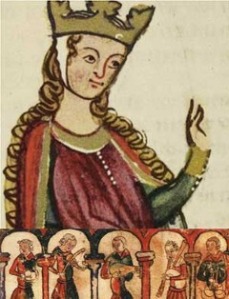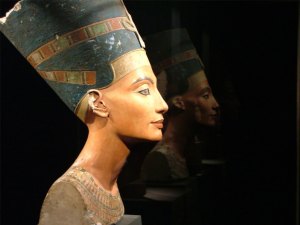Previously published:http://kellygalbraithblog.com/2013/07/03/325/
I was never one of those little girls that played dress-up in princess costumes and K-Mart tiaras preferring instead to pretend I was a famous detective carrying around a notebook and magnifying glass, or sporting a beret, assuming the identity of an undiscovered great poet whose musings were kept in a secret box. When I think of the life in store for the soon to be born baby of Prince William and Princess Catherine, I shudder. Boy or girl, this baby’s life is one of duty and responsibility. I am thinking about rulers of the past, and more often than not, my imagination turns to famous women rulers. Of course, the most familiar to me and I suspect to you, are both Elizabeth’s, 1st and 2nd. Our current queen we see every day on our money and her story is longer that most of our lives. Queen Elizabeth 1st has been a subject of many movies and novels. But there are other queens that have captured the love of their people and have had successful reigns. This blog post features colourful women that have worn the crown and clutched the scepter and music that was inspired by their story.
Eleanor of Aquitaine was the Duchess of Aquitaine, Countess of Poitiers, Queen of France and England and the Regent of England. She was the mother of the Queen of Spain, and the Holy Roman Emperor, King Richard. Eleanor was born to William X of Aquitaine around 1122 AD. When her father died, she inherited the realm of Aquitaine.
Eleanor was educated and a ruler who loved music and literature. On August 1, 1137, Eleanor was 15 when she married the future King Louis VII of France. It was no match made in heaven. Louis was pious, rather quiet and quite dull compared with the strong-willed Eleanor who was quite the going concern. She was rumoured to have had affairs and her fondness for her uncle, Raymond of Poitiers sent many tongues wagging in the realm. Eleanor and her husband had many battles over military strategy. She was shrewd and nobody’s fool. Even though she gave birth to two daughters while married to Louis she managed to get the marriage annulled. In the process she took back her dowry, land that was given to as a wedding present.
John Barry: The Lion in Winter- Suite From the film ‘Lion in Winter’ staring Katherine Hepburn as Eleanor.
 Eleanor didn’t waste any time. Less than 2 months after her marriage to Louis King of France ended, Eleanor married Henry Plantagenet, the grandson of England’s King Henry I. She was the older woman. It was even rumored that she previously had an affair with Henry’s father. Eleanor who had been Queen of France was now Queen of England. From this union she had 8 children. Richard I the Lionhearted, being the stuff of legend. Her husband was no retiring Louis and he had many affairs of his own. No doubt this fact, and the simple reality that she was not content to spend her days doing needle point while wars were being raged was a problem. Oh, yes, and she also supported her sons’ revolt against their father. Not a good move. She backed the wrong side and her husband threw her in prison for 15 years. Eleanor wasn’t released until his death.
Eleanor didn’t waste any time. Less than 2 months after her marriage to Louis King of France ended, Eleanor married Henry Plantagenet, the grandson of England’s King Henry I. She was the older woman. It was even rumored that she previously had an affair with Henry’s father. Eleanor who had been Queen of France was now Queen of England. From this union she had 8 children. Richard I the Lionhearted, being the stuff of legend. Her husband was no retiring Louis and he had many affairs of his own. No doubt this fact, and the simple reality that she was not content to spend her days doing needle point while wars were being raged was a problem. Oh, yes, and she also supported her sons’ revolt against their father. Not a good move. She backed the wrong side and her husband threw her in prison for 15 years. Eleanor wasn’t released until his death.
When her son Richard the Lionhearted tramped around on his Crusades, she was given vice-regal powers. Eleanor was a smart ruler. When Richard died, and John assumed power, he also listened to his mother’s advice. She arranged marriages for her children and grandchildren and tried to thwart family battles concerning claims to the throne. Eleanor died in a monastery in 1204 at 82. Historians have tried to label has many ways from ‘fatuous’ to a ruler who possessed: ‘good looks, charm, courage, passion, self-will, a hot temper, sound sense, and a taste for poetry and romance’.
Eleanor of Aquitaine was not a composer but her court was a centre for troubadour song. And she passed on her love of music to her children Richard the Lionhearted and Marie de Champagne who nurtured the trouvers of Northern France. Here is an anonymous tune from the 13th century, ’Welcome dear pleasant Bacchus, by whom our heart is gladdened. Such good noble wine makes a man courtly , honest and spirited.”
Bache Bene Venies (Anonymous, Codex Buranus 200)
Dido who lived around 814 BC was the Queen of the Phoenicians and the legendary founder of Carthage. Her story inspired Virgil’s ‘Aeneid’ and Christopher Marlowe’s ‘Dido, Queen of Carthage’. She was the daughter of the King of Tyre. After her brother killed her husband, she hightailed it to Northern Africa where she bought a piece of land. This city became one of the riches in antiquity, the city of Carthage.
Iarbus, the local chief who sold Dido the land, was putting serious pressure on her to marry him. She decided that she would rather stab herself in the presence of witnesses on top of her own funeral pyre than marry him!
In another version of the story, this time from the Roman poet Virgil, Dido meets Aeneas when he was shipwrecked in Carthage after fleeing Troy. She had vowed a life of celibacy after her husband was murdered. But she was smitten and professed undying love and devotion, and all that stuff. When Aeneas left her to fulfill his destiny of founding Rome, Dido was devastated and commits suicide. Later on, Aeneas does once again meet Dido, or some form of her…her ghost in Hades. She held a grudge and refused to speak to him.
Purcell -〈Dido and Aeneas〉”When I am laid in earth” / Emma Kirkby
Purcell -〈Dido and Aeneas〉” Nefertiti was Queen of Egypt long before the world had heard of Cleopatra. In 14th century B.C. Nefertiti was the powerful wife of Pharaoh Akhenaton. His ideas were radical. Instead of embracing polytheism, he advocated one God, and his name was Aten. As part of her religious conversion, she changed her name. Nefertiti which means ’The beautiful one is come’ became ’Neferneferuaten – Nefertiti’ or ’Perfect One of Aten’s Perfection.’
Nefertiti was Queen of Egypt long before the world had heard of Cleopatra. In 14th century B.C. Nefertiti was the powerful wife of Pharaoh Akhenaton. His ideas were radical. Instead of embracing polytheism, he advocated one God, and his name was Aten. As part of her religious conversion, she changed her name. Nefertiti which means ’The beautiful one is come’ became ’Neferneferuaten – Nefertiti’ or ’Perfect One of Aten’s Perfection.’
There is no doubt to her attractiveness. Her beauty was immortalized by sculptures of the time. An eulogy found on the temple wall reads: “And the heiress, Great is the Palace, Fair of Face, Adorned with the double Plumes, Mistress of Happiness, Endowed with Favours, at hearing whose voice the King rejoices, the Chief Wife of the King, his beloved, the lady of the Two lands, Nuferneferuaten-Nefertiti, May she live for ever and always.”
In Philip Glass’ opera ’Akhnaten’, Akhnaten, Nefertiti and monotheistic religion crumbles as the old order of many gods has returned.
Philip Glass – Akhnaten (Act I, Scene I: Funeral of Amenhotep III) (1983)
Mary Queen of Scots
was another ruler like Nefertiti who had her own issues with religion and it contributed to her losing head – well, that and that she threatened to topple another Queen, Queen Elizabeth 1st from her throne. Mary Queen of Scots, Mary Stuart was born in 1542 to King James V of Scotland and Mary of Guise. The king died when Mary was only 6 days old making her the new Queen of Scotland. When Mary was 6, her mother shipped her off to France because she realized that King Henry VIII of England would control her actions and her life.
Mary’s childhood spent in France was undoubtedly the happiest period of her life. She was a willing student who absorbed the sophistication of the French Court. It was during this period that Mary learned to play the lute. One court observer wrote, “She touched deftly with her beautiful white hand and her finely shaped fingers”. And although Melville could only report that Queen Elizabeth played ’reasonably for a Queen’, she probably played this galliard below.
John Dowland, Queen Elizabeth’s Galliard
When Mary was 16 years old, she married Francis II of France the son of King Henry and Catherine de Medici. When he died, Mary then 18, became a widow. She traveled back to her place of birth, Scotland. Court life was certainly not the sophisticated and lavish fare that she had been use to. Mary was a Roman Catholic girl, next in line to succeed the Protestant Queen. It was indeed unfortunate for Mary to have to leave France for Scotland during the time of the Reformation and John Knox.
John Knox, spoke of her arrival back in Scotland, “They very face of heaven, at the time of her arrival did manifestly speak what comfort was brought into this country, namely, sorrow, dolour, darkness and all impiety…The sun was not seen to shine two days before, nor two days after. That forewarning gave God unto us, but alas, the majority were blind.”
Mary was beautiful, a looker, no doubt about it. More beautiful than her cousin Elizabeth. She was smart too. But things started to take a turn for the worse when she let her heart rule her head.
She married Lord Darnley, an unpopular fellow by all accounts, and after too many intrigues of State, she was convinced that he was trying to kill her, Mary then became involved with the Earl of Bothwell.
He reportedly abducted her, and had his way with her, with or without her consent, and then married her. The Scottish nobles had had enough and locked her up on the island of Loch Leven. When she fled to England, her cousin Queen Elizabeth imprisoned her in the tower because she was convinced that Mary was plotting to have her assassinated.
Mary remained and was executed a Catholic at Fotheringay in 1587. She was only 44 years old. When Queen Elizabeth died, Mary’s son became James 1st King of England.
Robert Carver – Mass “Dum sacrum mysterium” a 10
Sacred Music for Mary Queen of Scots
Part 2 – The Queen of Sheba, Catherine the Great and Queen Krystina
Part 3 – Queen Victoria and Queen Elizabeth
by Kelly Galbraith www.kellygalbraithblog.com\